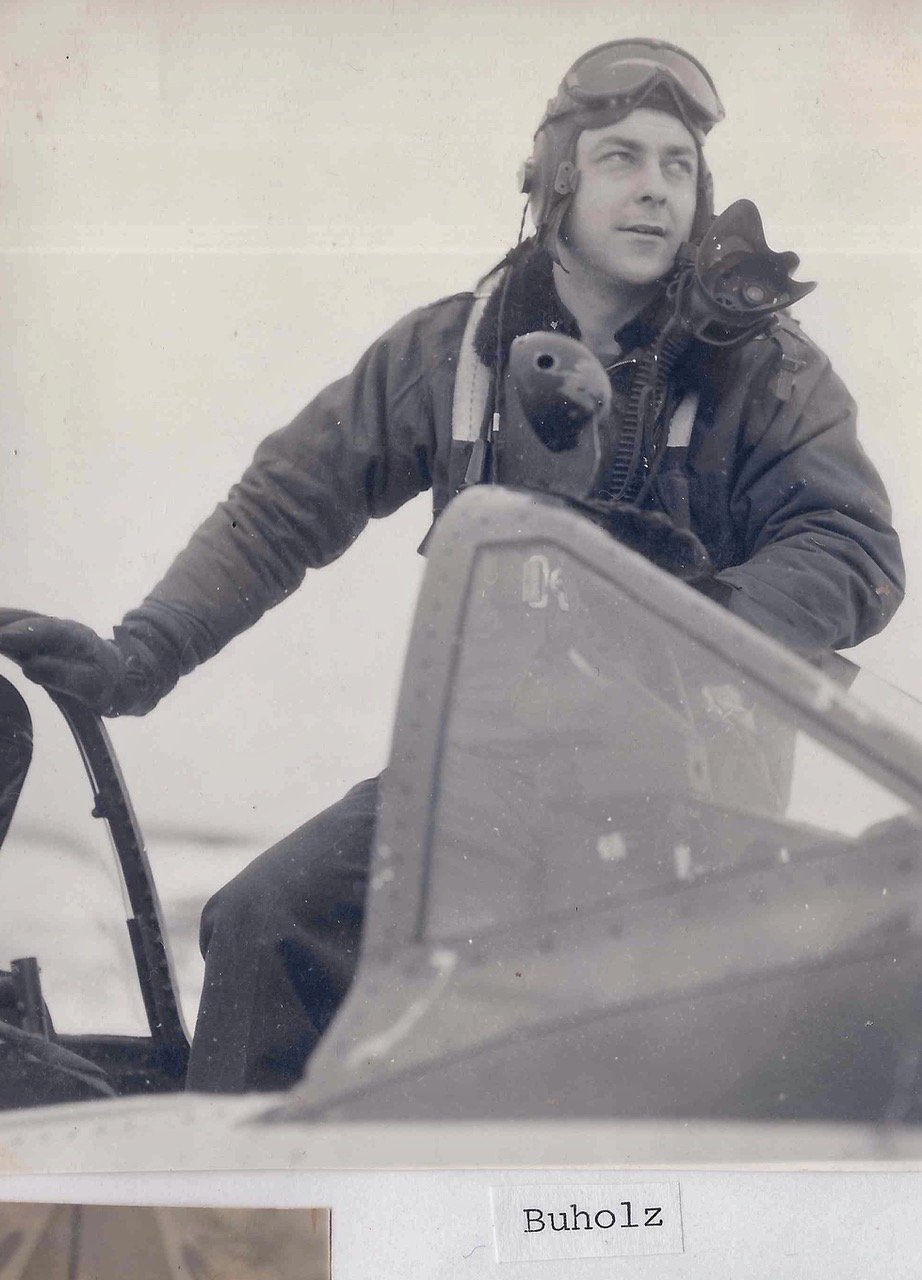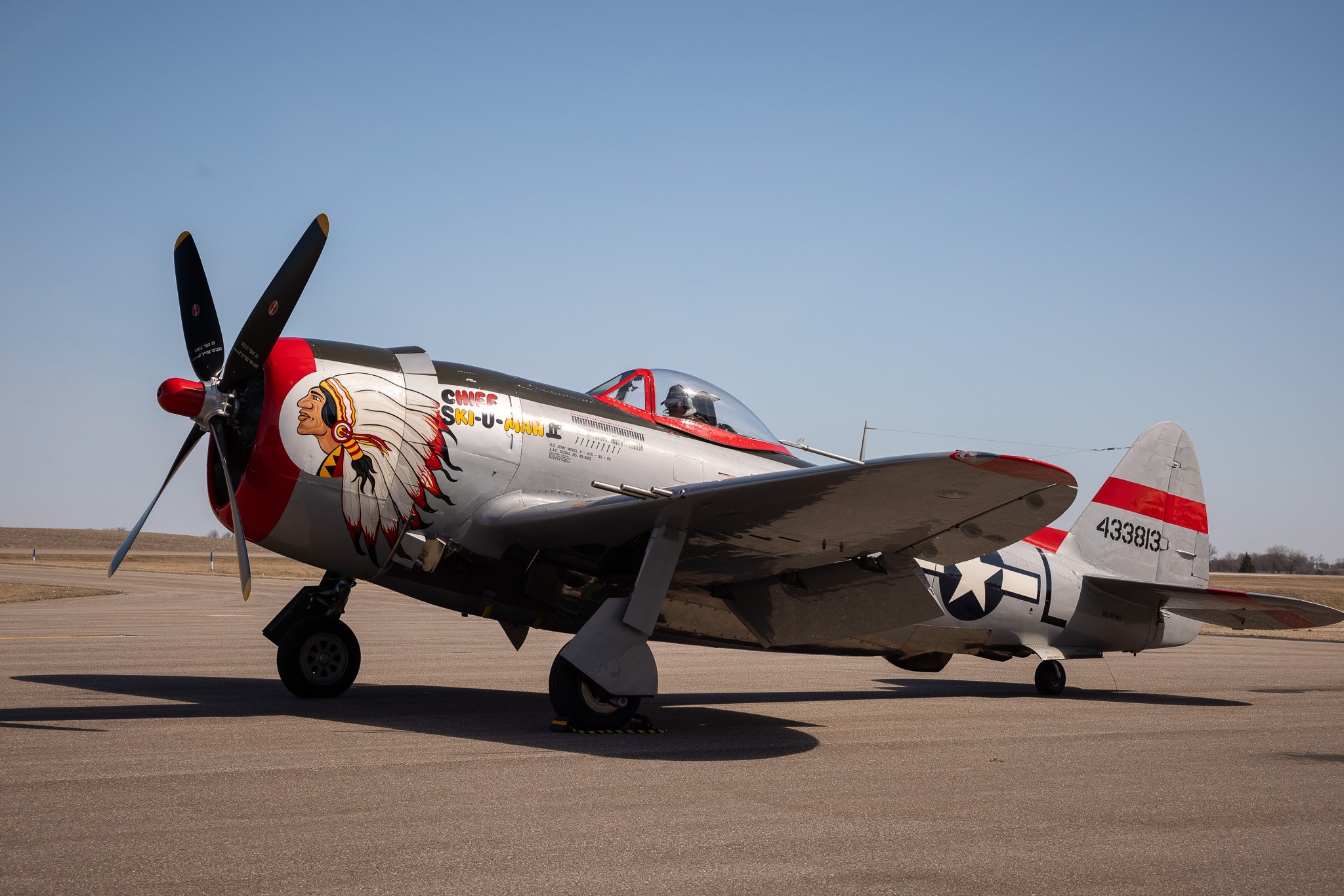“Chief Ski-U-Mah”
P-47D Thunderbolt
Nicknamed "Jug," the P-47 was one of the most famous and iconic fighter planes of the United States Army Air Forces during World War II. Originally conceived as a lightweight interceptor, the P-47 Thunderbolt evolved into a formidable heavyweight fighter that made its first flight on May 6, 1941. The first production model was delivered to the US Air Force in March 1942, and in April 1943 the Thunderbolt flew its first combat mission, a sweep over Western Europe. Renowned for its ruggedness, the P-47 was utilized as both a high-altitude escort fighter and a low-level fighter-bomber, able to absorb severe battle damage and continue flying thanks to its sturdy construction and air-cooled radial engine. During WWII, the P-47 served in almost every active war theater and in the forces of several Allied nations. By the end of the war, more than 15,600 Thunderbolts had been built, cementing the P-47's legacy as a true workhorse of the USAAF.
The P-47D Thunderbolt was a formidable fighter aircraft used extensively during World War II. Powered by a Pratt & Whitney R-2800-59 engine producing 2,430 horsepower, the P-47D could reach a maximum speed of 433 mph and a cruising speed of 350 mph. With a range of 1,030 miles and a maximum service ceiling of 42,000 feet, the Thunderbolt was capable of long-range missions and high-altitude operations. The aircraft was armed with a potent array of firepower, featuring six or eight .50 caliber machine guns. It could also carry up to 2,500 lbs of bombs, making it a versatile platform capable of both air-to-air and air-to-ground combat. The P-47D's impressive performance and firepower made it a crucial asset in the Allied air campaign during the war.
The paint scheme, "Chief Ski-U-Mah," belonged to WWII pilot, Lt. Duane Buholz from Ortonville, Minnesota, who served in the 405th squadron, 9th Air Force. The original artwork was painted by Sgt. Eli Gutierrez. Duane told Gutierrez that he wanted an Indian chief's head painted on his aircraft. Gutierrez told Duane that he was from Boston and didn't know what an Indian chief looked like. Duane found an Indian nickel and asked Gutierrez to copy the salient features from the coin. Later, Gutierrez presented Duane with a sketch for approval. Duane did not know why, but Gutierrez declined painting the name "Ski-U-Mah" onto his ship, so he did the work himself.
Under the cockpit, Duane had his name applied as a pilot and underneath printed, "Chief of the Sioux." Then he had his crew's names listed beneath. Instead of listing his crew chief in the usual manner, he had it printed like this:
S/Sgt. L.C. Wilson CHIEF OF THE CREW
Duane had three aircraft named "Ski-U-Mah." He got the name from the University of Minnesota rouser used at their football games. The word "Ski" is a Sioux Indian battle cry meaning "victory," and "U-Mah" coordinates with "Rah-Rah-Rah" and with condensing "University of Minnesota."
The Republic P-47 was one of the most famous and iconic fighter planes of the United States Army Air Forces during World War II. Originally conceived as a lightweight interceptor, the P-47 Thunderbolt evolved into a formidable heavyweight fighter that made its first flight on May 6, 1941. The first production model was delivered to the US Air Force in March 1942, and in April 1943 the Thunderbolt flew its first combat mission, a sweep over Western Europe. During WWII, the P-47 served in almost every active war theater and in the forces of several Allied nations.
Of the remarkable total of 15,683 P-47 Thunderbolts constructed during the tumultuous years of World War II, approximately two-thirds of these formidable aircraft were deployed to various overseas commands. In total, a significant number of 5,222 of these aircraft were lost throughout the conflict, with 1,723 of those losses attributed to accidents that were not related to combat. The P-47 consistently proved itself to be a robust and reliable fighter, successfully flying more than half a million combat missions and delivering an impressive total of over 132,000 tons of bombs to enemy targets. Despite the numerous challenges faced during these operations, Thunderbolts experienced a remarkably low loss rate of just 0.7 percent per mission. The skilled pilots of the P-47 also achieved an impressive aerial kill ratio of 4.6:1, further underscoring its effectiveness in combat. In the European Theater alone, P-47 pilots successfully destroyed more than 7,000 enemy aircraft, with over half of these victories secured in direct air-to-air combat, while the remainder were accomplished during perilous ground attack missions, showcasing the Thunderbolt’s remarkable versatility and effectiveness in a variety of combat roles. The armored cockpit of the P-47 was relatively roomy and comfortable, and the bubble canopy introduced on the P-47D offered excellent visibility for the pilots. Nicknamed the "Jug" owing to its distinctive appearance if it stood on its nose, the P-47 was noted not only for its formidable firepower but also for its impressive ability to resist battle damage and remain airworthy. A present-day U.S. ground-attack aircraft, the Fairchild Republic A-10 Thunderbolt II, takes its name from the legendary P-47, highlighting the lasting legacy of this iconic fighter. By the end of the war, the P-47's legacy as a true workhorse of the USAAF was proven. The P-47D's impressive performance and firepower made it a crucial asset in the Allied air campaign during the war.




